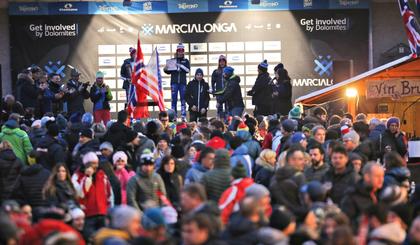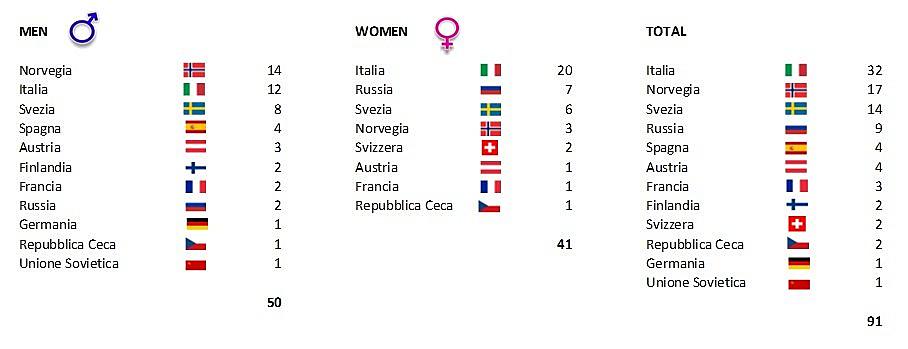Official Sponsors


26.01.2025

| News date | 29.10.2020 |
When taking part to Marcialonga everyone is the protagonist no matter which bib they wear, but in front of everyone there is also an agonistic aspect, where champions fight for their team and their nation to be on the podium.
Making an overall balance it was Norway winning the male category (14 gold medals), even if there had been only two Norwegians on the top step of the podium until 2003 (Magnar Lundemo in 1974 and Dag Atle Bjorkheim in 1982), and the Italian flag was waving more often until then.
In the female field, the victories are more varied and the Italian flag has been on top for decades (20 victories out of 41 races) On the contrart, Norway has won Marcialonga only three times in the female category.
Let's have a look at the medal collection divided by nations, in the female, male and total category. In the men field we see 50 nations over 48 editions as there were three shared victories in the years.
In 2021 we will see once more the Visma Ski Classics athletes fighting for the podium. The most blazoned teams are the ones from Scandinavia, like the Norwegian Ragde Eiendom (the one with the Aukland brothers) and the Swedish Lager 157.
Lots of athletes will be fighting for Italy: Panisi, Busin, Capello and Chiara Caminada for the Team Robinson Trentino, Brigadoi, Ferrari, Stefania Corradini and Antonella Confortola for the Sottozero Gold Team Zorzi Max Orsaiec, the Mich brothers, Amhof, Crestani, Mosconi representing Team Futura Trentino Alta Quota.
The Italian teams will have to push really hard to defeat the Scandinavian champions, but we keep on dreaming of the Italian flag on the podium, maybe even on the highest step.

At the first edition in 1971, the spotlight was on him: Franco Nones, the local hero, who had just won the Olympic gold medal in Grenoble a couple of year earlier, in 1968. But Ulrico Kostner defeated him, winning the first Marcialonga. It is interesting to read the story of the first race and the protagonists of the first edition (Read the magazine of the first edition > ).
The first foreigner to cross the finish line was the Swedish athlete Tommy Lindby, ranked 7.
1972 was the year of the Finnish skier Pauli Siintonen, famous for introducing a new skiing technique, the Siitonen technique, prelude of the free technique, where one ski was within the track and the other one would push from the outside.
The Swedish flag waves at the third edition as Lars Arne Boelling wins, after winning several editions of Vasaloppet.
Interesting fact for the 1974 Marcialonga: the yet unknown skier Magnar Lundemo wins; he is a Norwegian athlete starting with a very high bib (5442) but with a final sprint he cuts off the Finnish champion Siintonen. Third ranked is the Italian Tonino Biondini, who will succeed in 1976 crossing the finish line first.
The sixth edition in 1977 goes to the French Jean Paul Pierrat, but it is impressive how Maurilio De Zolt set up a lonely getaway ended some kilometers before the finish due to hunger pangs.
1978 represents the comeback of the great Ulrico Kostner, who already won the first edition and participated to the race sicne then. Finally the race opens up for women and the French Dominique Robert Chavanne is the first to conquer the podium.
In 1979, there is another Finnish victory with Jorma Kinnunen, second and last Finnish winning the race. In the female field, the epic era of Maria Canins Bonaldi starts, who has been triumphing for ten years in a row.
In 1980, Pauli Siintonen is the favorite, but the team play of the Sovietic skiers Jurasov and Garanin gets the better of the race and Garanin crosses the finish line first.
The Swedish Lundbaek, Olympic gold medallist in the Sapporo 15 km, meets everyone's expectations and wins in 1981.
Once more a foreign victory in 1982, with the Norwegian Dag Atle Bjorkheim.
1983 the race ends in Predazzo. A heart-pounding final, where Maurilio De Zolt lost the victory to Walter Mayer right at the final sprint.
The Swedish Bengt Hassis crosses the finish-line first at the 13th edition in 1984.
1985 is the year of local skier Giorgio Vanzetta, applauded at the finish by a cheering crowd.
The following year sees once more an Italian on the podium: Maurilio De Zolt, called “Grillo (cricket)” wins over Orjan Blomqvistat the final sprint.
Maurilio De Zolt completes also his 16th Marcialonga (1987) but has to share the podium with the Swedish Anders Blomqvist, this is the first case of shared victory. He tries to win for the third time in a row in 1988 but at the final sprint he is defeated by another Italian skier, Albert Walder from Dobbiaco-Toblach.
This is the year of the tenth success of Maria Canins, right in front of the athlete from Castello di Fiemme, Paola Nones.
After two years in which Marcialonga could not take place for lack of snow, the 18th edition takes place in 1991. It is once more the turn of De Zolt as big protagonist and winner, both for 1991 and 1992.
After the ten victories, Maria Canins is not at the start as she has the flu, but another Italian skier wins the 18th edition: Guidina Dal Sasso in on the top of the podium. Starting from the following year and for four years in a row, the vicotry in the female field goes to a Russian skier, first with the double victory of Tatiana Bondareva, followed by Elena Kalughina in 1994 and Eugenia Bitchougova in 1995.
In 1993 we find the Russian victory even in the male field, with Michail Botvinov at the first place.
1994, another shared victory by the Italian Silvano Barco and the German Johann Muhlegg, on the finish line together.
The 22nd edition in 1995 talks French: the Formula 1 pilot Jean Alesì is on the track, skiing amongst excited spectators, but the winner is Herve Balland.
In 1996 we see once more a spectacular sprint deciding upon the winner: Maurizio Pozzi gets the better of Giorgio Vanzetta. In the women's category, Guidina Dal Sasso wins, confirming her leadership for the following four years.
1997 we see once more Michail Botvinov on the highest step of the podium running for Austria, as he just had been confirmed the Austrian citizenship. It is once more him, winning the race in 1998 under the Austrian colors.
At the 26th edition in 1999, Marcialonga sees once more a shared victory, but this time we have a particular fair-play victory: it is the Spanish Johann Muhlegg (who already shared a victory in 1994, running for Germany at the time) and Juan Jesus Gutierrez, who cross the finish line holding hands.
The following year we saw Fulvio Valbusa at the lead, proceeding firmly towards the finish line chased by Leonardo Follis and Fabio Giacomel. He managed to obtain the victory by few centimeters. The Russian Svetlana Nageikina gets the better of the other women with a broad margin.
In 2001 the Spanish Gutierrez stands out, and in the female field we find once more a Russian athlete, lirina Skladneva.
Gutierrez got a taste for winning and once more, he distances the others on the Cascata climb and crosses the finish line first. The Italian flag waves from the female podium, thanks to Anna Santner.
In 2003 Marcialonga is held again in Classic Technique and the race is faced by the top athletes only using their arms, launching the technique of the following years. Joergen Aukland is the winner; the Norwegian star will also conquer the editions n. 33 (2006), 39 (2012) and 40 (2013). Amongst the ladies, the victory goes to the Italian Lara Peyrot.
The 2004 success remains not only in Norway, but in the Aukland family; this year it is the older brother Anders winning the 31st edition and will double it in 2008. Going back to 2004, we saw the success of Gabriella Paruzzi, who also won the World Cup in that year thanks to the participation to Marcialonga.
The Czech Repubblic is for the first time on the highest step of the podium in 2005 thanks to Stanislav Rezac, while the athlete from val di Fiemme Cristina Paluselli wins the women's category both in 2005 and 2006: she will be the last Italian winning Marcialonga.
In 2007, at the 34th edition, it is the Swedish skier Jerry Ahrlin conquering the victory and leaving Jorgen Auklad and a good Marco Cattaneo behind; he was the last Italian skier on the podium. The Norwegian Hilde Pedersen wins the female race, where the Swedish Jenny Hansson will triumph the following year.
In 2009 we saw once more Jerry Ahrlin and Hilde Pedersen on the podium of the 36th Marcialonga.
2010 is an edition with almost a full Swedish podium: Oskar Svard wins ahead of Ahrlin and Anders Aukland (NOR), while in the ladies' field we find Jenny Hansson first, Sandra Hansson second and Susanne Nystrom third.
Jerry Arhlin conquers his third victory at Marcialonga in 2011; in the female category the Swiss skier Seraina Boner wins.
The Swedish athlete Susanne Nystrom, who already arrived third, conquers the victory in 2012, while Seraina Boner wins again in 2013.
The Norwegian Simen Ostensen surprises everyone winning the 41st edition. In the female field, great performance of the Russian Julia Tikhonova, who manage to keep the favorite Boner and Annika Lofström behind.
2015 the series of three victories singed by Tord Asle Gjerdalen who comments the race saying: “I believe that Marcialong ais the most beautiful race to face, right after the Olympics, for the race charachter and location, start and finish in different beautiful places, the sensational Cascata climb challenging us until the last km, is the best climb. Vasaloppet is quite suggestive too, but Marcialonga crosses villages and it involves the athletes into something different, special".
Katerina Smutna, Czech athlete representing Austria, wins the female category.
Talking about the ladies' field, in 2016 we saw the fight on the final stretch between Smutna and the Swedish athlete Britta Johansson Norgren, with Norgren winning over Smutna, who conquers the podium in 2017 again, this time representing the Czech Republic.
In 2018,the victory goes to Russia withIlya Chernousov and in the female field Sweden got the better of the race withNorgren.
It is once more Norgren winning the race in 2019 while Petter Eliassen conquers the gold medal for Norway.
In 2020, the highest step of the podium goes to Norway both in the male and female field, with Kari Vikhagen Gjeitnes and Tore Bjorseth Berdal on top.
Main Sponsors




Official Sponsors


Sustainable Partner

Official Suppliers





















Official TV Broadcaster

Institutional Partners






Friends


Under the patronage of
